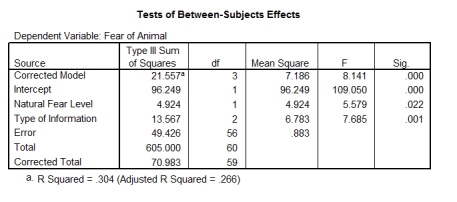A psychologist was interested in the effects of different fear information on children's beliefs about an animal.Three groups of children were shown a picture of an animal that they had never seen before (a quoll) .Then one group was told a negative story (in which the quoll is described as a vicious,disease-ridden bundle of nastiness that eats children's brains) ,one group a positive story (in which the quoll is described as a harmless,docile creature who likes nothing more than to be stroked) ,and a final group weren't told a story at all.After the story children rated how scared they would be if they met a quoll,on a scale ranging from 1 (not at all scared) to 5 (very scared indeed) .To account for the natural anxiousness of each child,a questionnaire measure of trait anxiety was given to the children and used in the analysis.Which of the following statements best reflects what the effect of 'Natural Fear Level' in the table tells us? 
Definitions:
Gordon Allport
A psychologist known for his theory of personality that emphasized the uniqueness of the individual and the concept of personal traits.
Personality Theory
A system of concepts, assumptions, ideas, and principles proposed to explain the variations in personality among individuals.
Psychoanalytic Theory
A theory of personality and therapeutic technique that attributes thoughts and actions to unconscious motives and conflicts, developed by Sigmund Freud.
Object-relations School
A psychoanalytic theory focusing on relationships with others and the external and internal objects people form attachments to, shaping personality.
Q2: Are directional hypotheses possible with chi-square?<br>A)Yes,but only
Q3: Based on the scree plot below,how many
Q4: What data transformations are necessary before loglinear
Q10: Approximately what is the median success score
Q11: It is assumed that the dependent variable
Q15: In an experiment involving cholesterol levels in
Q17: In such a study,questions are grouped into
Q20: Other things being equal,compared to the paired-samples
Q21: The Hotelling-Lawley trace is?<br>A)The sum of eigenvalues
Q22: How are the degrees of freedom for